STEAM Faire Goes Virtual
Virtual tours, STEM student group presentations, and an early look at the Hall of Science
After the tour, student leaders of various STEM clubs and groups convened via Zoom to introduce their clubs and answer questions. The clubs cover a wide range of STEM interest and include the Aerospace Society, Not Math Club, BioClub, Public Health Society, Phi Delta Epsilon (Pre-Medical Fraternity), and HOSA: Future Health Professionals. Underrepresented Students in STEM was also present, which aims to address underrepresentation in STEM fields.
Finally, the STEAM Faire concluded with another informal tour led by Walters-Conte, through the life sciences and chemistry departments of the new Hall of Sciences. It began with Meg Bentley, Senior Professorial Lecturer and Director of Biology Teaching Labs, showcasing the amazing new tools and instruments available for students in the introductory biology labs. The tour then went to the Chemistry Department to talk with Matthew Hartings, Associate Professor of Chemistry, about the work being done in the new research labs. Next, the tour moved on to Monika Konikleva, Associate Professor of Chemistry and her research assistant, pre-med post-baccalaureate alum Mari Cohen, to discuss their work in the new facilities. Naden Krogan, Associate Professor of Biology then introduced his work with plant development. Finally, Biology graduate student Maria Ochiai and undergraduate Public Health student Taylor McManus talked about the student research experience in their new lab with Katie DeCicco-Skinner, Associate Professor of Biology.
While the STEAM Faire had to make major adjustments this year, it offered a window into the flourishing world of STEM at American University.
Hall of Science Complete and Opening Doors
Marks new era for science at AU
Construction on AU’s gleaming, brand new Hall of Science has been
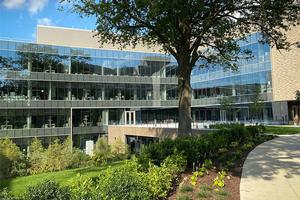
Hall of Science, August 2020
completed, and the building will be opening its doors for labs and classes in compliance with the latest health and safety guidelines. The building is the latest development in AU’s ambitious commitment to further scientific research to address some of the world’s most pressing problems, from environmental degradation to disease and health disparities.
**Please note that the building is not open without advance permission at this time!
The 125,000-square-foot facility houses AU’s biology, environmental science, chemistry, and neuroscience departments. It joins the Don Myers Technology and Innovation Building, which was completed in 2017 and houses physics, mathematics and statistics, computer science, the AU Game Lab, the Kogod Center for Innovation, and the Design and Build Lab.
Watch a time-lapse of the construction taken from a webcam atop Beeghly Hall.
“The Hall of Science is a campus jewel: a brilliant, state-of-the-art facility supporting the cutting-edge research conducted by our science faculty and students who can learn right alongside them in high-tech labs and classrooms,” says Max Paul Friedman, interim dean of the College of Arts and Sciences. “It’s concrete-and-glass evidence of our commitment to a renaissance in the sciences at AU.”
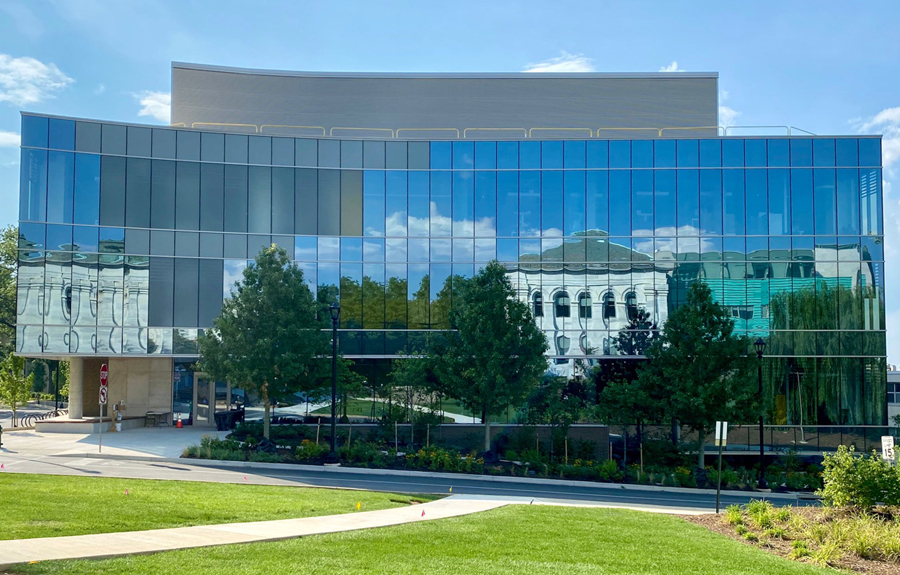
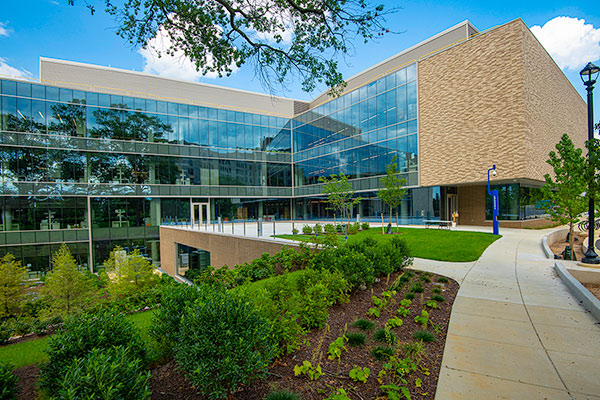
Read on for updates on individual departments.
An Investment in the Growing Sciences
Science is the fastest-growing area of undergraduate study at American University. Over the past several years, College of Arts and Sciences faculty have grown their research funding by more than 100 percent, securing more than 50 unique awards from the National Institutes of Health and National Science Foundation. Together, the Hall of Science and the Don Myers Technology and Innovation Building will position the university to receive more funding grants as its researchers utilize the facility’s advanced labs and infrastructure.
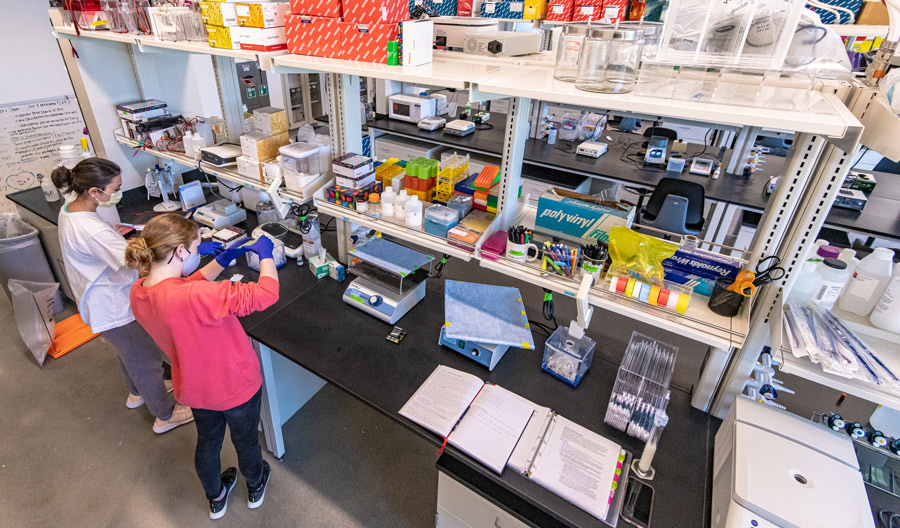

Department of Neuroscience
This summer, the university launched a new Department of Neuroscience under the leadership of Terry Davidson, who was named Distinguished Professor of Neuroscience by AU’s Board of Trustees this spring. The department will move into the Hall of Science next month.
“The opening of the Hall of Science, with its state-of-the-art laboratories and core research facilities, will be a transformative event for the Department of Neuroscience,” says Davidson. “It will increase the ability of our faculty and students to gain the knowledge of the brain and nervous system that is needed to address current and future challenges to human health and well-being.”
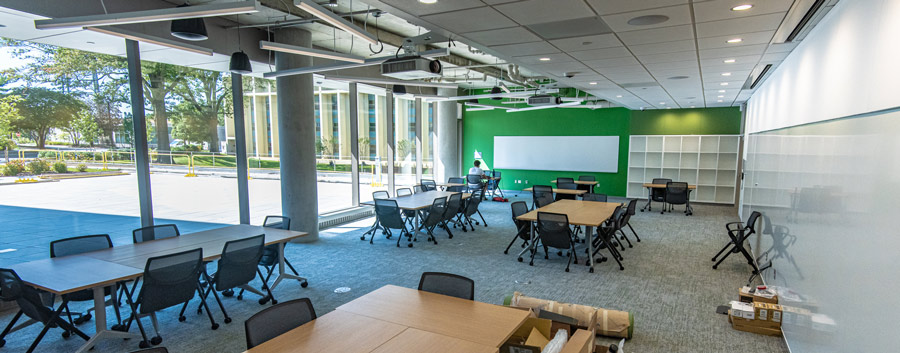
Department of Biology
Katie DeCicco-Skinner, associate professor and biology department chair, says that her department is looking forward to all the possibilities that the building holds, from new opportunities for collaboration across disciplines, to high-tech labs and equipment.
“The modern, shared laboratories are designed to foster interdisciplinary collaboration and integrative approaches to shared research problems in the areas of cellular and molecular biology, physiology, computational biology, cancer, developmental biology, evolution, and genetics,” she says.
“The abundant natural sunlight in the teaching and research laboratories make the space inviting, and ample social spaces and write-up rooms will facilitate communication between students. Additionally, the molecular, tissue culture, computational, and imaging core facilities, which flank research laboratories, will give biology faculty and students access to some of the most cutting-edge technologies.”
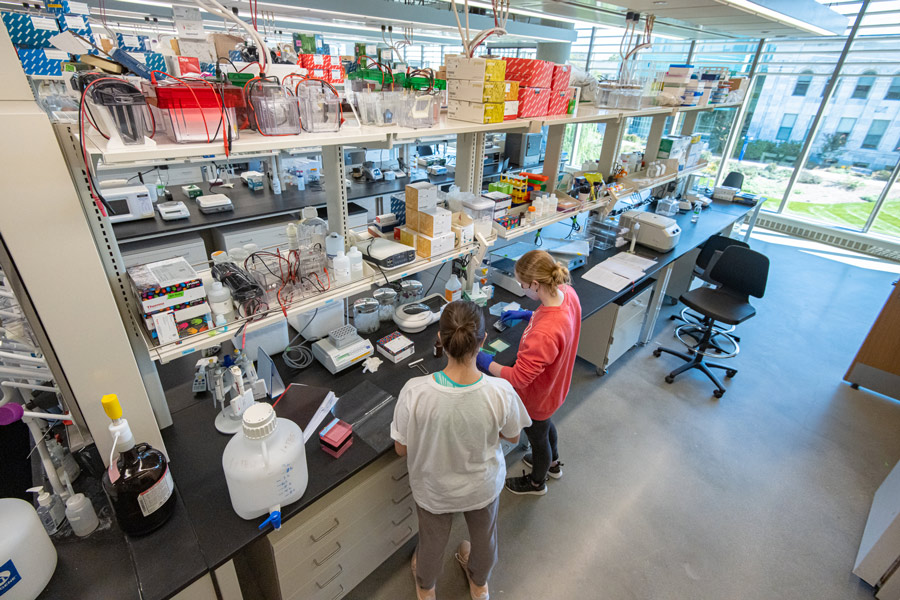
Department of Environmental Science
Stephen MacAvoy, professor of environmental science and department chair, says that ENVS faculty and students are excited and eagerly anticipating enhanced collaboration with the other physical and biological scientists.
“The physical and biological sciences at AU have seen tremendous growth over the last decade and the Hall of Science will usher in another period of unprecedented achievement,” he notes. “For environmental science teaching and research, the new facilities offer greatly increased capacity for ecohydrology, geochemistry and ecology as well as modeling, remote sensing and data visualization.”
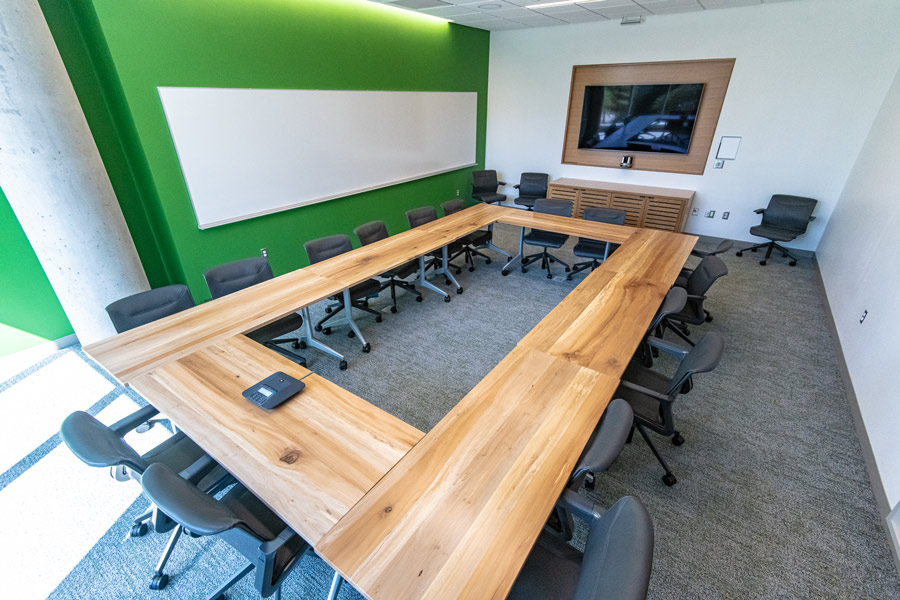
Department of Chemistry
“For our department, the opening of the Hall of Science enables new abilities and capacities to conduct research and teaching in materials science, forensic chemistry, drug development, biosensors, chemical weapons proliferation, computational chemistry, and food chemistry,” says Shouzhong Zou, professor of chemistry and department chair.
“The lecture hall will provide advanced technologies for more engaging and innovative research and teaching presentations,” he explains. “The advanced laboratory for our majors broadens our capability to train students in modern instrumentation in a research environment. The dedicated chemistry of cooking laboratory is a kitchen in a lab, which showcases how chemistry is everywhere in our life and is the central science. The Hall of Science as a science hub on campus fosters close collaboration among researchers from physical and biological sciences to data sciences.”
All images by Jeff Watts.
Freddie Mac Summer Internships Lead to Job Offers
Life-changing experience for AU computer science students
Last spring, Mike Ryan, VP of Tech Strategy and head of the Freddie Mac’s Tech Modernization department, came to American University to recruit students for summer computer science internships. Five AU undergrads landed these internships, and three of them were offered full-time job positions at Freddie Mac after graduation.
Freddie Mac, the Federal Home Loan Mortgage Corp, is a stockholder-owned, government-sponsored enterprise, which was chartered by Congress in 1970 to keep money flowing to mortgage lenders in support of homeownership and rental housing for middle-income Americans. It purchases, guarantees, and securitizes mortgages to form mortgage-backed securities. It is headquartered in Tysons Corner, Virginia, and ranked No. 38 on the 2018 Fortune 500 list of the largest United States corporations by revenue.
“We are especially excited about this new partnership because Freddie Mac reached out to our university to find newly trained STEM professionals with both technical and workplace skills,” says Kathryn Walters-Conte, AU’s Director of STEM Partnerships and Outreach Director of Master’s in Biotechnology.
Parker Brotman (BS statistics, data science track ’20) begins fulltime work at Freddie Mac in January. Last summer, he interned in the Tech Modernization department of Freddie Mac’s IT division. “My main internship project was using data science tools and methodologies to investigate how the Multifamily division could use information about competitor’s bids to improve its own bids in order to win more deals and increase revenue,” he explains. “I also participated in a business case challenge along with the other IT interns, and I became AWS Cloud Practitioner certified.”
Angélica Maria Vega Aponte (BS computer science ’21) will begin working fulltime at Freddie Mac next summer. Last summer, she interned in the same department as Brotman. “I worked on developing backend Python code to create a background research web app within the multifamily division of Freddie Mac using search API’s and Sentiment Analysis Models,” she says. “This experience allowed me to further develop my python coding skills and become extremely familiar with Kibana and AWS Cloud services, specifically EC2 and S3 components.”
Internship to Career
Brotman said he was inspired to pursue the opportunity because Ryan explained that interns would get the opportunity to learn in-demand skills such as AWS. Vega Aponte agrees. “Mike Ryan’s presentation on new cloud service technologies such as AWS, along with his emphasis on Freddie Mac being a ‘Majority Minority’ company, is what inspired me to pursue the internship,” she says.
During Vega Apone’s internship, she was chosen to speak alongside Freddie Mac CEO David Brickman during the corporation’s end-of-internship celebration—in front of hundreds of employees. She then received an internship at NASA this fall as a software engineer and graphic design intern. “After this experience [at NASA], I will then be working with Freddie Mac as a technology analyst after graduation, where I will continue to further develop my coding skills, continue to pursue my passion for technology, and create a platform for all Minority Women in Computer Science,” she says.
Brotman says that he enjoyed working with the other interns, and even though they were fully online, they built a real sense of comradery. “I enjoyed learning about the business and what it’s like to data science in a real business setting,” he explains. “All the people that I worked with at Freddie were wonderful. On the whole, the internship was a big success.”
Well Prepared by AU
Both students are grateful to AU’s computer science faculty, particularly Professor Mohammad Owrang Ojaboni, who arranged Ryan’s recruiting visit to American University along with Walters-Conte. “Thanks to Professor Owrang and the many wonderful computer science professors at AU, I was able to prepare myself for the professional world and land an internship at an awesome company such as Freddie Mac,” says Vega Aponte.
Brotman adds that the skills he learned at AU both in class and by working as a research assistant prepared him well for the internship. He has some advice for fellow students who are thinking about internships. “My biggest piece of advice is to attend all the on-campus professional/recruiting events that match your interests and make an effort to form connections with the company representatives at these events,” he says.
I-Corps: The “I” Is for Innovation, the “S” Is for Success
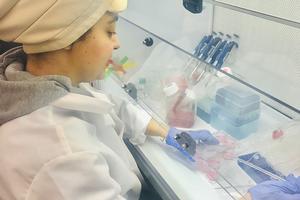
Rana Said works at a fume hood in Hurst Hall.
In spring 2018, American University became an official I-CORPS site. I-CORPS is a National Science Foundation-sponsored program aimed at developing science and technology entrepreneurship. Three semesters, 13 teams, 12 faculty mentors, and 20 students later, the results are in: I-CORPS is a resounding success.
Students in the I-CORPS program at AU have been admitted to medical school and engineering PhD programs, secured global innovation internships, and gained employment in technology firms. Some have even patented their technologies and are continuing to research their projects by working with the American University Center for Innovation (AUCI).
Irena Volkov is one such success story. One of the inaugural students in the I-CORPS program at AU, Volkov established Surgicure Technologies, LLC through the AUCI Incubator. Her company developed and patented a bite block and medical tube securing device, which allows patient airways to remain open during medical procedures while preventing damage to skin and teeth. She is currently pursuing a PhD in the Medical Engineering and Medical Physics program run by MIT and Harvard.
I-CORPS curriculum teaches early stage product and business development using the Lean LaunchPad model, which focuses on “customer discovery”—using customer crowdsourcing techniques and interviews to determine whether a venture idea has commercial merit. The program provides students with $2,250 to develop their ideas, including building prototypes in AU’s Design and Build Lab.
“I became more confident talking to people,” says Rana Said, a biotechnology MS graduate who is currently in the PhD program in Biotechnology in the Department of Chemical and Biochemical Engineering at Tufts University. “The interviews helped me find the way to the question I wanted to answer, and having my project related to research I was doing was really powerful.” Said worked with Biology Professor John Bracht on research into weight loss proteins while at AU, and through I-CORPS developed a device that allows for easier, painless delivery of weight loss therapies based on both her lab research and her customer discovery results.
Success also is in the cards for I-CORPS students continuing at AU. Colleen Baldwin is now working in the AUCI on her project, Moodbase, a wearable technology that monitors mental health. Baldwin, along with Volkov, won prestigious VentureWell e-team awards that provide funding and support to promising student inventors and entrepreneurs.
Chemistry Professor Alexander Zestos has also taken his research to the next level. After mentoring Alexander Mendoza, who graduated with a neuroscience degree this spring, in the commercial development of a brain monitoring probe, he and his team have been invited to participate in the National I-CORPS program this summer.
By developing marketable skills through the Design and Build Lab, teaching product development techniques, and providing a platform for science communication, I-CORPS at AU is clearly fostering both innovation and success. “I-CORPS has opened many opportunities for me,” says Said. “What I did in I-CORPS really nailed the essence of biotechnology: the application of scientific research to real technology.”
The Impact of Mentorship
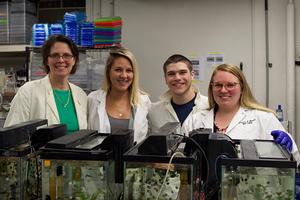
Dr. Connaughton stands with students in the Zebrafish Ecotoxicology, Neuropharmacology and Vision Lab.
When we sat down to write an article for Catalyst, the two of us searched for meaningful parallels in our vastly different lives. We continually returned to interactions we’ve had with our advisor, Dr. Victoria Connaughton, who runs AU’s Zebrafish Ecotoxicology, Neuropharmacology & Vision Lab (ZENV). Dr. C’s mentorship has had a critical impact on the trajectory of our academic and personal lives during our time at American University. We sat down to talk with Dr. C about the importance of mentorship, and how to foster our own future mentor/mentee relationships.
You have been a successful neurobiologist for more than twenty years and have dedicated much of that time to the success of your students. How do you define mentorship? Who are your mentors?
To me, a mentor is someone who is willing to take the time to help or train another person so they are able to succeed. Often this is a professional relationship, where the mentor trains/ guides someone as they develop skills relevant to a career. I consider my doctoral advisor and one of my postdoc advisors to be my mentors.
Knowing how often we lean on you, it’s obvious that mentorship is a considerable investment of time and energy. Is it worth it? What sort of benefits do you see?
It is definitely worth it! One benefit that I see repeatedly is growth in the students. When students enter the lab, they often have little research experience; some only have experience through laboratory courses. However, by working in the lab and interacting with others who are there, I can really see their personal growth. They gain confidence in their abilities. Graduate students often become so comfortable and confident that they become mentors themselves by recruiting and training undergraduate students to help with their research.
The role of mentors is a difficult one, you are tasked with supporting the goals and aspirations of your mentees, but also ensuring they develop the skills required for career advancement. How do you find a balance?
The dialogue is important. To have a successful mentoring relationship, it is important to communicate and to be willing to listen and take the time to have those conversations. Why do they want to obtain research experience? What are their plans and goals?
How important are mentors in the scientific field?
Very important. In science, there are pedigrees of an individual’s research training, which can be significant. Much of what is taught/learned in science is done by doing and by interacting with advisors and mentors. The relationship between mentor and mentee is key in that training. Although the mentor-mentee relationship is primarily characterized by a focus on academic and career support, a personal relationship is a common aspect of a successful relationship.
Do you think helping your mentees balance their personal and professional life is an important part of your mentor role?
Mentoring often does start out with a focus on professional training. However, as communication between mentor and mentee continues and is maintained (for months or years), other topics are discussed. Everyone has a personal and a professional life, and balancing those different aspects is very important because they are linked. If something is not going well in your personal life, it affects your professional life. Consequently, it is natural for a mentormentee relationship to include discussions of non-career components. How the balance between personal and professional life occurs can vary from person to person, and mentors can provide guidance, share their experiences, or be a sounding board for different ideas.
During our time as your students, Cassie has become Melissa’s mentor, and Melissa has taken on her own mentee, Angelo. Do you have advice for developing a relationship with mentees?
Finding a mentor can be deliberate – you can ask someone to mentor you – or it can just develop over time, like when the mentor-mentee relationship develops between an advisor and his/her student. To be a mentor, I suggest thinking about the strong relationships you have (such as an existing mentor-mentee relationship) and what characteristics of that relationship are important to you and successful? What characteristics are less successful? To me, having a good mentoring relationship requires (1) interest and investment in training the person and in developing the dynamic and dialog, (2) willingness to take the time and be available for training, and (3) an ability to listen and be thoughtful and honest in your responses.
Thinsat Program
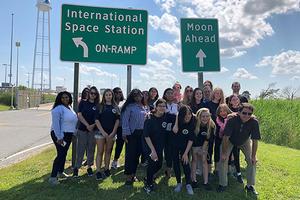
Space exploration has always been an exciting, yet challenging and costly task. Theories and explorations related to outer space have always been important. Passionate students of all ages at the Twiggs Space Lab, NASA Langley Research Center (LaRC), and Near Space Launch have launched a small satellite program called ThinSat to increase student engagement and interest in Science, Technology, Engineering, and Mathematics (STEM) related fields.
ThinSat is a small satellite with the ability to transmit data from an extreme low earth orbit (ELEO).
The ThinSat program is a three-phase curriculum designed by Twiggs Space Lab. The process includes designing, developing, testing, and operating ThinSats, along with collecting, analyzing, and presenting data acquired with onboard sensors. Phase I is an introductory phase where the participants are introduced to concepts related to satellites and remote sensing. During Phase II, the candidates build and learn more about satellites, engineering, and remote sensing. They also design their experiments for high-altitude weather balloons. Phase III is the most anticipated, where students launch their custom-designed satellites into orbit. It takes a ThinSat five-to-six days to enter ELEO. During this time the students collect, analyze, and interpret the data. A ThinSat utilizes unused space resources and does not create orbital debris. It is a single-layer satellite with one printed circuit board, making it easy to design, build, and assemble.
On April 17, 2019, at 4:46 p.m., sixty ThinSats were launched from Pad 0A of the Mid-Atlantic Regional Spaceport located at NASA Wallops Flight Facility as the secondary load on Northrop Grumman’s Antares rocket. As of April 18, 2019, forty-nine of the ThinSats carrying standard and custom payloads were transmitting data (Virginia Space).
American University has recently formed the new Institute for Integrated Space Science and Technology (ISSTI). The goal of ISSTI is to support and grow AU’s partnerships with other area institutions involved in space science. It supports nearly twenty externally funded research faculty working on twelve active projects, with total grant funding of more than $7.4 million from NASA, the National Science Foundation, and other sponsors. Presently, ISSTI and AU’s Department of Physics, in partnership with Virginia Space, operator of the Mid-Atlantic Space Port, are working to launch three student-built ThinSats. They are being built in the Design and Build Lab within the Don Myers Technology and Innovation Building. As part of the collaborative, AU students and faculty are working with local schools to expose younger students to the process. Specifically, AU is working with high-school students at H.D. Woodson STEM High School in Washington, DC, and middle school students at St. Elizabeths Catholic School in Rockville, Maryland, to create components for the AU ThinSat. AU students and faculty, along with students and teachers from each of the partner schools, also traveled to the Wallops Flight Facility the past May.
“The program has been a gateway for AU students for getting involved in the Design and Build Lab and getting technical experience. The program also gives students at the college, high school, and middle school levels the opportunity to expand their world views on all the different fields within space science,” Dr. Cyndee Finkel said.
The ThinSat Program is creating amazing opportunities for AU students, staff, and faculty to work together on cutting-edge space science and technology.